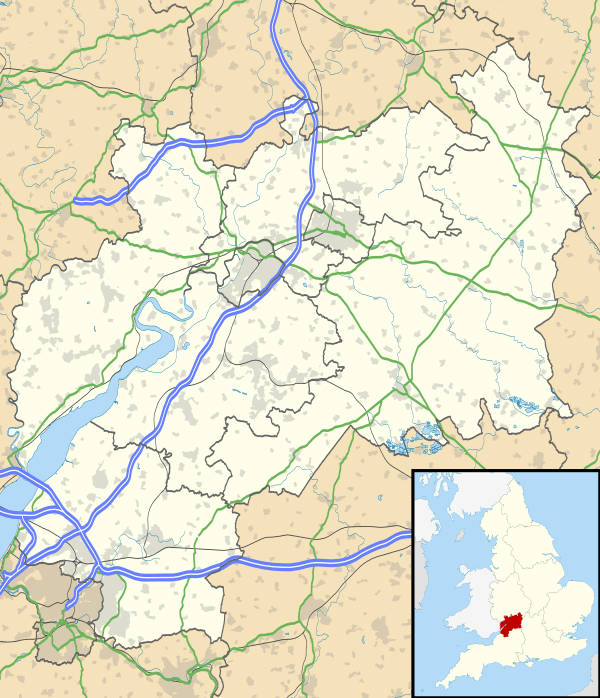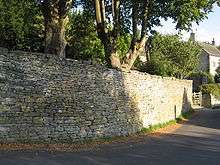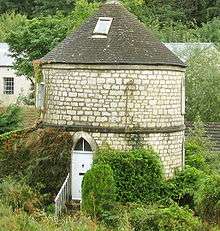Chalford
| Chalford | |
|---|---|
 Frome valley showing Chalford High Street | |
 Chalford Chalford shown within Gloucestershire | |
| Population | 6,215 (2011 census)[1] |
| OS grid reference | SO898028 |
| Civil parish |
|
| District | |
| Shire county | |
| Region | |
| Country | England |
| Sovereign state | United Kingdom |
| Post town | Stroud |
| Postcode district | GL6 |
| Dialling code | 01453 |
| Police | Gloucestershire |
| Fire | Gloucestershire |
| Ambulance | South Western |
| EU Parliament | South West England |
| UK Parliament | |
Chalford is a large village in the Frome Valley of the Cotswolds in Gloucestershire, England. It is to the southeast of Stroud about 4 miles (6.4 km) upstream. It gives its name to Chalford parish, which covers the villages of Chalford, Chalford Hill, France Lynch, Bussage and Brownshill, spread over 4 square miles (10 km2) of the Cotswold countryside. At this point the valley is also called the Golden Valley.[2]
Governance
An electoral ward in the same name exists. This ward covers a similar area to the parish but extends to the Brimscombe and Thrupp ward. The total population of the ward taken at the 2011 census was 6,509.[3]
History
The remains, and known sites, of many barrows indicate that the plateau area of Chalford Hill, France Lynch and Bussage has been an area of continuous settlement for probably at least 4,000 years.[4] Stone Age flints have been found in the area as well as the remains of a Roman Villa. Several of the place names in the area are also Anglo-Saxon in origin.
The name Chalford may be derived from Calf (Way) Ford, or possibly from the Old English cealj or Chalk and Ford (river crossing point). There were two ancient crossings at Chalford apart from the ford from which the village was named: Stoneford, recorded from the later 12th century, was the crossing-point of a track up Cowcombe hill on the line of the later Cirencester turnpike[5] and by 1413 another track crossed into Minchinhampton by Stephen's bridge at Valley Corner.[6]
Chalford Hill is a recent title for the western end of the hill: Its original name was Chalford Lynch. "Lynch" (lynchet in modern English)[7] means a cultivated terrace following the contours of a hill. Chalford Lynch and its extension France Lynch originated in the late 16th century as collections of stone cottages many built illegally on the peripheries of Bisley common as the mill expansion in the valley outstripped accommodation space in the valley.[8] Many dwellings in Franch Lynch and Chalford Hill only became legitimate at the time of the parliamentary enclosures in 1869.[9]
The settling of displaced Flemish Huguenot weavers in the 17th and 18th centuries brought quality silk and woollen cloth manufacturing to the valley. Some say that they gave their name to the neighbouring village of France Lynch. It is more likely that the name comes from a non-conformist chapel, France Meeting that was displaced from the village in the valley to the Lynches above.[10] At this point the Golden Valley is narrow and deep so many weavers' cottages were built clinging to the sides of the hills, giving the village an Alpine air. It is sometimes still referred to as the 'Alpine village'.[11] As the paths on the hillsides were too narrow for more conventional forms of transport donkeys were used to carry groceries and other goods to houses, this tradition continuing until as recently as the 1950s.[12] Chalford expanded rapidly with the opening of the Thames and Severn Canal in 1789 and the village became one of the centres for the manufacture of broadcloth. Its wealthy clothiers lived close to their mills and built many fine houses which survive to this day.
Architecture

In common with other towns and villages in the area, buildings are generally constructed of Cotswold stone, with local fields enclosed by dry stone walling. The area is designated as an Area of Outstanding Natural Beauty and the village itself is a designated conservation area.
Chalford is noted for two fine Arts and Crafts movement churches. Christ Church (Church of England) contains work by Norman Jewson, William Simmonds,[13] Peter Waals, Edward Barnsley, Norman Bucknell,[14] amongst other distinguished artists and craftsmen working in the Cotswold tradition. The Church of Our Lady of the Angels (Roman Catholic), Brownshill, by W. D. Caroe (1930), contains outstanding stained glass by Douglas Strachan. France Lynch, part of the civil parish but a separate ecclesiastical parish has a splendid listed church, St John the Baptist, built by George Frederick Bodley who went on to build Washington National Cathedral in Washington DC.


One of the most distinctive, and most photographed, features of the village is the Round House. It was built by the Thames and Severn Canal Company as a lengthman's cottage and is one of five along the Thames and Severn Canal.[15] (The others are at Coates, Cerney Wick, Marston Meysey and Inglesham.) A notable feature is that access is by way of steps up to the first floor as the ground floor would have originally been stabling for a horse. Apart from a relatively short break in the 1950s when it was a museum it has fulfilled its function as a private residence, which it continues to do to this day.
Directly opposite the Round House is Chalford Place, a Grade II* listed building built on the site of the original home of the de Chalkfordes who are mentioned in documents as early as 1240.[15] The house, formerly known as the Companys Arms, is one of the earlier houses in the valley. Built as a mill owner's house it became an inn in the 19th century. It owed its name Companys Arms to the East India Company for which the mills of Chalford supplied much of its cloth. It remained an inn until the 1960s when it reverted to its former name of Chalford Place.[16] The house lay derelict for many years until it was recently purchased and is now being restored by the artist Damien Hirst
|
Surviving mills in Chalford parish.
The mill race of Ashmeads Mill remains, mill demolished early 1900s. |
Notable former mill owners' houses.
|
Listed buildings[17]
- Grade II* : Chalford Place, St John the Baptist, St Mary's House, Wing Cottage
- Grade II : Baptist Chapel, Church of St Michael and All Angels, Christ Church, France Congregational Church and Hall
Modern Chalford
In February 2008, Chalford hit the headlines when a community plan to reintroduce donkeys as a way of carrying shopping up the steep, narrow hills became public.[18][19][20]
On 5 September 2009 Chalford Community Stores allowed customers to purchase shares in the business. The store, which has been running with the aid of a volunteer workforce since 2003, is now affiliated with the independent organisation Co-operatives UK, making the share issue possible.[21] On 4 March 2012 the store and the donkey were featured in an episode of Countryfile. The store prospered within the local church hall but returned to the High Street in May 2014 and now thrives in the former Seventh Day Adventist Hall. This was made possible by a second community share issue which raised in excess of £50,000 alongside a bank loan and various grants.
Chalford is home to the national literacy charity Readathon.[22]
Residents
Notable residents include James Bradley, the third Astronomer Royal, who died in Chalford in 1762, and the 19th-century sculptor John Thomas. Henry Cooper lived in the village as a child, after being evacuated here during the Second World War.[23] The artist Damien Hirst has a studio in the village. Lord Janvrin, former Private Secretary to H.M. the Queen, maintains a house in the village and on his retirement was gazetted as Baron Janvrin of Chalford Hill, on 10 October 2007. The Public Relations guru Mark Borkowski lives at Oakridge.
Brownshill
The sub-village of Brownshill is home to the Monastery of Our Lady and St Bernard which is home to a community of eight Bernardine Cistercian nuns.[24] There is a sister community at the Monastery of Our Lady of Hyning at Warton, near Carnforth.
St Mary of the Angels is a small Roman Catholic church built at Brownshill in the 1930s with funds from two former nurses, Bertha Kessler and Katherine Hudson. The architect was W. D. Caroe, with windows by Douglas Strachan.[25]
The Golden Valley
The question of how the Golden Valley acquired its name is sometimes asked.
The first written reference to the Golden Valley is in Rudder's 1779 History of Gloucestershire. (It can be assumed that the name pre-dates his recording of it but how far back in unknown other than a reference in Issac Taylor's map dated 1777 - see Point 4 below.)
The Place Names of Gloucestershire, published in 1965 by the University of Cambridge and edited by A H Smith, notes that Rudder's is the first written record and also notes 'doubtless so called from the wealth that came from its industries.' However, there is no substantiation or source for this particular observation. It is also worth noting that Rudder records that a Roger Gulden held lands in the area in the middle Medieval period, therefore it is possible that in fact this is the source of the name as a corruption of the surname.
From time to time, people will claim that it was Queen Victoria who named the Valley sometime during her reign. This is a myth and she is not responsible for giving this delightful valley the name, which clearly has a significantly longer history. On the other hand she did pass through the Golden Valley twice in the summer and on both occasions made a note in her Journals.
On 29 September 1849, Queen Victoria traveled from Gloucester to Swindon by train,
"Before we came to Gloucester we passed through the beautiful valley of Stroud, so green & hilly, but soon after Swindon, all beauty of scenery faded away." (So green and not golden.)
Three years later on August 30, 1852 she wrote,
We passed Reading & at 2 reached Swindon, where we got out & had some luncheon. Left again in less than ½ an hour, & passed by the very pretty & picturesque valley of Stroud, which is full of manufactures scattered about, & this makes one hardly realise, that it is a manufacturing district. After 3 we reached Gloucester, & here we left the Great Western for another line. The Malvern Hills could be distinctly seen in the distance. We stopped at ½ p. 4 at Broomsgrove station, where the Worcestershire Yeomanry, with Mr Clive, their Col: were drawn up, Sir J. Packington & Ld Lyttelton, being also there with their wives, &c.
Later in the 19 century the use of the Golden Valley had become common:
1. A Handbook for Travellers in Gloucestershire, Worcestershire, and Herefordshire published 1867 records when describing the rail journey to Stroud 'the traveller is carried along the side of a steep valley, thickly timbered, whose tints in autumn have given it the name the Golden Valley.'
2. THE JOURNAL OF HORTICILTURE, COTTAGE GARDENER, COUNTRY GENTLEMAN. BEE-KEEPER ...By GEORGE W.JOHNSON,F.R.H.S. published in Country Life in 1870 refers to the 'golden valley in Stroud and beautiful it is.'
3. Paul Hawkins Fisher in his Notes and Recollections of Stroud, published in 1871 describes the Golden Valley and notes that 'in autumn it is all a-glow with the bright golden tints of its beech leaves.'
Finally...
4. The Victoria County History for Gloucestershire Vol 11 published in 1976 '..Golden Valley in the south-east part, which had acquired its name by the late 18th century, either from its autumn hues or from the prosperity of the local cloth-mills,' and refers to Issac Taylor's 1777 map of Gloucestershire as a footnote.
Any mention of Queen Victoria naming the valley 'golden' is recent, without verification, and seems confined to a few blogs, an article in the Stroud News and Journal, a couple of guide books, and mentions on the radio station BBC Gloucestershire.
See also
- Aston Down airfield across the Golden Valley from Chalford
References
- ↑ "Parish population 2011". Retrieved 29 March 2015.
- ↑ Information Britain
- ↑ "Ward population 2011". Retrieved 29 March 2015.
- ↑ The Vernacular Architecture and Buildings of Stroud and Chalford : Nigel McCullagh Paterson Pub. Trafford Publishing, 2006 ISBN 1-4120-9951-X,
- ↑ British History Online
- ↑ A History of the County of Gloucester: Volume 11: Bisley and Longtree Hundreds (1976)
- ↑ Both forms derive from the Anglo-Saxon hlinc.
- ↑ Ralph Bigland 1791: Historical Monumental and Genealogical Connections Relative to the County of Gloucester
- ↑ Gloucestershire records office; Parliamentary Bisley Inclosures: 1869, Q/RI 22
- ↑ France Congregational Church, Chalford: Story of 257 years, 1662-1919 Paperback – 1919:by Herbert W Gurd. France Congregational Church.
- ↑ "Archived copy". Archived from the original on 11 May 2008. Retrieved 2008-09-27. Cotswolds Canal Trust
- ↑ Donkey direct: Hilly hamlet brings back beast of burden to carry shopping after 50 years
- ↑ "William and Eve Simmonds, between them : Artist, Carver / Sculptor, Photographer, Embroiderer, Book Illustrator, Marionette Maker and Puppet Master · Oakridge Community Archives". Oakridgecommunityarchives.org. Retrieved 2018-07-19.
- ↑ Mary Greensted. "Obituary: Norman Bucknell | From". The Guardian. Retrieved 2018-07-19.
- 1 2 Chalford Guide. Pub. Chalford Parish Council 1990
- ↑ The Vernacular Architecture and Buildings of Stroud and Chalford : Nigel McCullagh Paterson Pub. Trafford Publishing, 2006 ISBN 978-1-4120-9951-6
- ↑ Stroud District Council Archived 23 July 2011 at the Wayback Machine.
- ↑ Independent newspaper
- ↑ Daily Mail
- ↑ BBC News
- ↑ Residents snap up hundreds of pounds of shares in village shop
- ↑ "Readathon. Reading to help children in hospital". Readathon.org. 2015-05-03. Retrieved 2018-07-19.
- ↑ Boxing legend Cooper's Stroud links
- ↑ "Brownshill". Bernadine Cistercians of Esquermes.
- ↑ "Brownshill St Mary of the Angels, Chalford, Glos". Friends of Friendless Churches. Archived from the original on 6 August 2012.
External links
| Wikimedia Commons has media related to Chalford. |